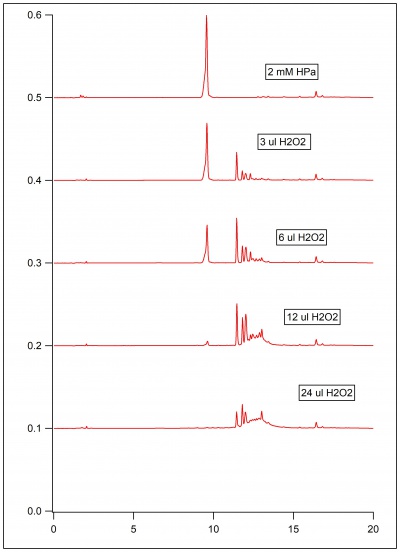HPA Project
Project Overview
For this project, the goal was to quantify the concentration of HPA remaining in solution after a reaction between hydrogen peroxide, horseradish peroxidase, and HPA is completed. To do this we made standards of known concentrations of HPA, made reaction vials of the hydrogen peroxide, enzyme (horseradish peroxidase), and HPA. We ran these through the HPLC to collect the data.
My research partner, Will Fox, ran a similar experiment with acetaminophen, the link to his page can be found here.
Making the Samples
This project required HPA standards to be made. The following link describes this process.
Our actual samples to be tested required the making of a 2 mM HPA pH 5 buffer stock solution, a hydrogen peroxide stock solution, and a horseradish peroxidase solution.
2 mM HPA Buffer Stock Solution
Put the 2 mM HPA standard into a bottle and add a pH 5 buffer tablet. Stir until dissolved.
Hydrogen Peroxide Stock Solution
Measure 5 mL of water into a scintillation vial. Add 283 microliters of 30% hydrogen peroxide to the water. This provides a hydrogen peroxide solution of about 0.413 M.
Horseradish Peroxidase Stock Solution
Preparing the Final Samples
Measure out 5 mL of the 2 mM HPA buffer stock solution into 4 different scintillation vials. Add hydrogen peroxide solution in different amounts to each vial (3 microliters, 6 microliters, 12 microliters, and 24 microliters). Add 10 microliters of horseradish peroxidase solution to each vial.
Instrumentation
After making the standards, we tested the standards using the HPLC to see where the peaks were for the different concentrations of HPA.
The following link goes into more depth about working with the HPLC:
What the HPLC Tells Us
We ran these samples through the HPLC at the wavelength of 275 nm, which is the lambda max for HPA. Running the samples at this wavelength tells us how much the samples absorb at this wavelength.
Data Analysis
To analyze the HPLC data, the data was exported as an arw file. This file was then loaded into Igor, which we used to make chromatograms. Chromatograms allowed us to gain a better understanding of the how each concentration of HPA absorbs at 275 nm for our standards, and how each sample absorbs at 275 nm. We used the information from the chromatograms to make standard curves in excel. The slopes of the standard curves gave us an equation we could use to find the concentration of a sample using the absorbance.
Example standard curve data can be found here.
Equation
The following equation was used to find the concentration of caffeine in our samples. The equation is solved for x, which is concentration, then the absorbance is plugged in for y and solved.
y = 0.0486x + 0.0021
R² = 1
Chromatogram Data
Gepasi
We used the software Gepasi to analyze the kinetics of the reaction between horseradish peroxidase (HRP) and hydrogen peroxide. Gepasi simulates how the compounds will react with each other. The following link describes how to run Gepasi:
We used several different HRP reactions to collect data from Gepasi. These reactions can be found here.
Gepasi Graphs
Data Summary
From Gepasi we learned that the enzyme is recycled much more quickly when the rate of the HRP 2 is increased. This means only a small amount of the enzyme is required when the rate of the HRP 2 is higher.







